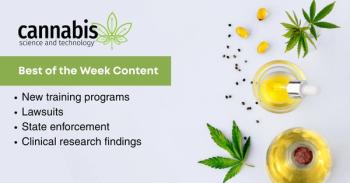
Ask the Experts: Cannabis Testing/Analytical Methods, Part I: What Is the Biggest Challenge Facing the Cannabis Industry?
Leading scientists and researchers from the cannabis industry-Bob Clifford, Shimadzu Scientific Instruments; Derek Laine, Trace Analytics; Sandy Mangan, SPEX SamplePrep LLC; Justin Steimling, Restek Corporation; and Katherine Stenerson, MilliporeSigma-participate in this round-table discussion series. This month they discuss the biggest challenges in cannabis related to testing and analytical methods.
What is the biggest challenge facing the cannabis industry from your point of view?Bob Clifford: One of the biggest challenges is the disconnect between the states’ legal cannabis programs and the lack of a legal oversight program from the federal government. In theory, it’s possible for there to be 50 different requirements for each analytical test method for cannabis. For example, the testing of heavy metals varies by state. Pennsylvania requires testing of what are generally referred to as the “Big Four”: arsenic (As), cadmium (Cd), lead (Pb), and mercury (Hg). Maryland also requires testing of these “Big Four” elements but also adds barium (Ba), chromium (Cr), selenium (Se), and silver (Ag) to its list. New York also includes the “Big Four” plus five additional elements, though not Ba, Se, and Ag as in Maryland, but antimony (Sb), copper (Cu), nickel (Ni), and zinc (Zn).
Solvents used to extract the cannabinoids and terpenes also vary by state. Maryland only has a list of eight residual solvents whereas Oregon has an expansive list of 45 solvents. At the same time, New York has zero tolerance, since supercritical fluid extraction can only be used to extract the cannabinoids and terpenes.
It’s a similar story relating to pesticides. Maryland has a list of 48 compounds, Oregon has 59, California has 66, and Massachusetts only lists nine pesticides. In addition to the different number of pesticides, the maximum residual limit (MRL) varies from state to state.
Canada requires testing of 95 pesticides. International and domestic organizations, such as AOAC International, ASTM International, American Oil Chemists' Society (AOCS), and United States Pharmacopeia (USP), are all developing methods for analytical cannabis testing. AOAC is in the process of increasing the number of pesticides tested to 104 with the maximum levels at 50% of any state or province in the U.S. and Canada. Some states blindly follow the regulations other states have set and assume they are correct in level and compound type, which may or may not be based on risk factors of these contaminants.
Some states require testing of aflatoxins B1, B2, G1, G2, and mycotoxin Ochratoxin A. The compounds and levels for these are the most consistent across state lines if required.
Another problem with the federal prohibition is that round robin testing with these organizations cannot be done unless they are intrastate. Round robin testing circulates known matrices, analytes, and concentrations as an unknown sample to multiple laboratories in various states to prove a method is validated and rigorous. The best method is then adopted as the method of choice for that organization to be used domestically or worldwide.
Derek Laine: Oversupply and wholesale price declines as well as federal prohibition and lack of interstate commerce are a challenge and risk for the industry. Laboratories providing quality assurance testing services are affected by industry economics while also trying to find a balance between client satisfaction, regulatory compliance, and providing scientifically robust data. An example of this difficulty is that the U.S. Drug Enforcement Administration (DEA) places an upper limit on the concentration of commercially available cannabinoid standards. This in turn makes the preparation of a calibration curve more difficult, more time consuming, and more expensive. This expense has to be balanced with demands from clients for low cost testing.
Sandy Mangan: I would have to say the lack of published information or standardization makes it very difficult to develop validated methods or even protocols. The industry and regulations are constantly changing. Since each state mandates their own testing requirements and guidelines, and some states are much more stringent than others, it’s sometimes hard to implement testing protocols that a laboratory may deem as “good laboratory practices” simply because they have different regulatory requirements. A few years ago QuEChERS (quick, easy, cheap, effective, rugged, and safe) was the preferred method for pesticide residue extraction. If you talk to most chemists and scientists in the industry currently, they will now tell you there are much more accurate ways than QuEChERS to extract and quantify pesticides. That’s just an example of how things change as we learn and grow in this industry. I have seen a lot of laboratories pop up that have no idea what type of instrumentation is needed or the costs involved in running a certifiable laboratory.
Another challenge is that there are so many different cannabis based products out there. The testing requirements for bud or flower as opposed to infused products vary, not to mention the preparatory steps involved to get them into a workable state. It’s no secret that there is still a stigma surrounding the cannabis industry. Testing laboratories certainly become targets. When you read stories about laboratories being shut down for falsifying results or not following protocol, it only hurts the way the industry is perceived.
Justin Steimling: From a testing perspective, I would say that both the quantity and variety of the matrices that need to be analyzed presents a huge challenge. A method that works for flower is not always going to translate well to edibles or personal care products. Manufacturers have certainly not limited their creativity when formulating cannabis infused products, which has created the need for very specific testing methods to ensure that target compounds are not only efficiently extracted, but also appropriately analyzed to account for any differences in the matrices.
Katherine Stenerson: I think one of the bigger challenges with regards to testing is lack of consensus methods. While states provide targeted analyte lists and required levels for testing, they do not provide guidance or requirements with regards to how the testing is done. For example, potency testing can produce variable results depending on the method used, and this is one of the more important tests with regards to accuracy from the standpoint of patients and consumers.
Look for part II of "Ask the Experts: Cannabis Testing/Analytical Methods" in our May 2019 newsletter. Two other series with experts on extraction and cultivation will be launching in March and April, respectively.
Newsletter
Unlock the latest breakthroughs in cannabis science—subscribe now to get expert insights, research, and industry updates delivered to your inbox.


